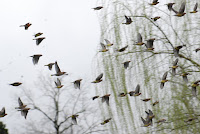

Yesterday I went hiking with my friends, Terri and Rod, up to Porter's Creek in the Greenbriar section of the Smokies. The trail is an easy 3.7 miles to the campsite at the end. There is a beautiful creek, a waterfall (Fern Falls), the Smoky Mountain Hiking Club cabin (built in 1936), an old cemetery, log bridges, rock walls, and lots of moss-covered boulders to enjoy along the trail.

It was the first time there for all of us. We had heard it is a spectacular trail for wildflowers, but I was afraid we were a little too early to see many. We saw some Spicebush, Round-leaf Violets, Carolina Spring Beauty a
 nd Bloodroot at the beginning of the trail. But a big surprise was waiting for us after we crossed the second log bridge and started climbing the hill! The entire area was carpeted in Sharp-lobed Hepatica (right), Carolina Spring Beauty, Trout Lily, yellow Round-leaf and Halberd-leaf Violets, a couple of early Fringed Phacelia, and even some Dutchman's Breeches! In a couple of weeks that area is going to explode in wildflowers! It will be a carpet of white with the phacelia, trillium, chickweed, and others.
nd Bloodroot at the beginning of the trail. But a big surprise was waiting for us after we crossed the second log bridge and started climbing the hill! The entire area was carpeted in Sharp-lobed Hepatica (right), Carolina Spring Beauty, Trout Lily, yellow Round-leaf and Halberd-leaf Violets, a couple of early Fringed Phacelia, and even some Dutchman's Breeches! In a couple of weeks that area is going to explode in wildflowers! It will be a carpet of white with the phacelia, trillium, chickweed, and others.

One thing we were not happy to see were the Hemlock Wooly Adelgids! These tiny white
 insects drain the life out of even the largest Eastern Hemlock trees. It was sad to see so many skeletons of what were once majestic trees. The trees at the campsite had been treated with injected insecticide to prevent infestation, but it is impossible for the rangers to treat every tree in the park. Some other methods being used to kill these non-native insects are soap spray and tiny black beetles that have been introduced to eath them. The loss of these magnificent trees has been devastating in many parts of the park.
insects drain the life out of even the largest Eastern Hemlock trees. It was sad to see so many skeletons of what were once majestic trees. The trees at the campsite had been treated with injected insecticide to prevent infestation, but it is impossible for the rangers to treat every tree in the park. Some other methods being used to kill these non-native insects are soap spray and tiny black beetles that have been introduced to eath them. The loss of these magnificent trees has been devastating in many parts of the park.















